Financial Performance: Statement Analysis, Ratios, Improvement
VerifiedAdded on 2023/06/18
|15
|2540
|58
Report
AI Summary
This report provides a comprehensive analysis of financial management principles, emphasizing the importance of financial statements and ratio analysis in evaluating business performance. It covers key aspects such as financial planning, fund protection, and optimal fund utilization. The report examines the role of income statements, balance sheets, and cash flow statements in assessing profitability, liquidity, and efficiency. Furthermore, it includes a business review template with calculations using Excel to produce an income statement and balance sheet for a sample organization. Based on the case study information, the profitability, liquidity, and efficiency of the company are described using ratio analysis. Finally, the report outlines several ways to improve the financial performance of a business, including lowering expenses, consolidating debts, and recovering outstanding payments. The document aims to provide insights into effective financial management practices and strategies for enhancing organizational wealth, and is available on Desklib for students seeking study resources and solved assignments.

Importance of financial
management
management
Paraphrase This Document
Need a fresh take? Get an instant paraphrase of this document with our AI Paraphraser
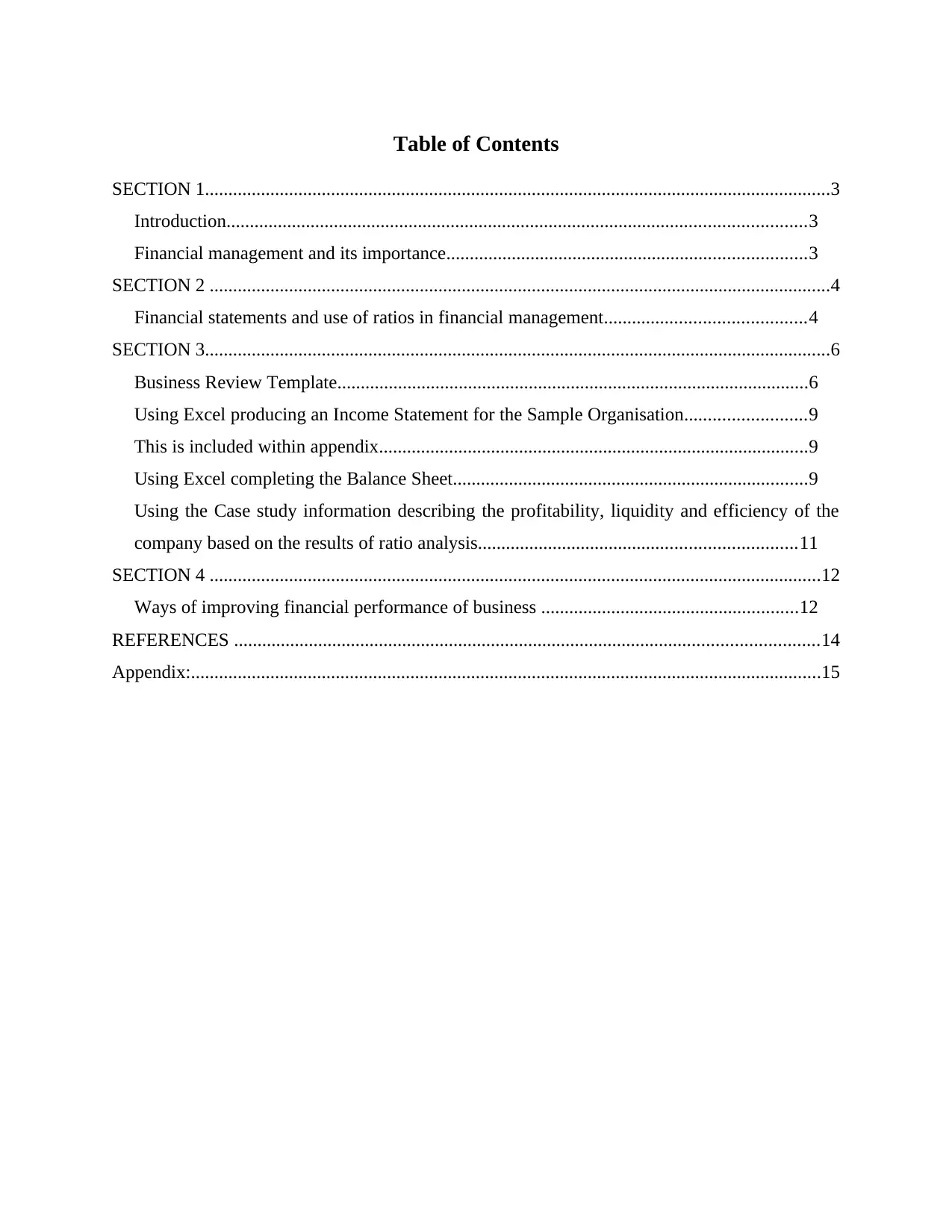
Table of Contents
SECTION 1......................................................................................................................................3
Introduction............................................................................................................................3
Financial management and its importance.............................................................................3
SECTION 2 .....................................................................................................................................4
Financial statements and use of ratios in financial management...........................................4
SECTION 3......................................................................................................................................6
Business Review Template.....................................................................................................6
Using Excel producing an Income Statement for the Sample Organisation..........................9
This is included within appendix............................................................................................9
Using Excel completing the Balance Sheet............................................................................9
Using the Case study information describing the profitability, liquidity and efficiency of the
company based on the results of ratio analysis....................................................................11
SECTION 4 ...................................................................................................................................12
Ways of improving financial performance of business .......................................................12
REFERENCES .............................................................................................................................14
Appendix:.......................................................................................................................................15
SECTION 1......................................................................................................................................3
Introduction............................................................................................................................3
Financial management and its importance.............................................................................3
SECTION 2 .....................................................................................................................................4
Financial statements and use of ratios in financial management...........................................4
SECTION 3......................................................................................................................................6
Business Review Template.....................................................................................................6
Using Excel producing an Income Statement for the Sample Organisation..........................9
This is included within appendix............................................................................................9
Using Excel completing the Balance Sheet............................................................................9
Using the Case study information describing the profitability, liquidity and efficiency of the
company based on the results of ratio analysis....................................................................11
SECTION 4 ...................................................................................................................................12
Ways of improving financial performance of business .......................................................12
REFERENCES .............................................................................................................................14
Appendix:.......................................................................................................................................15
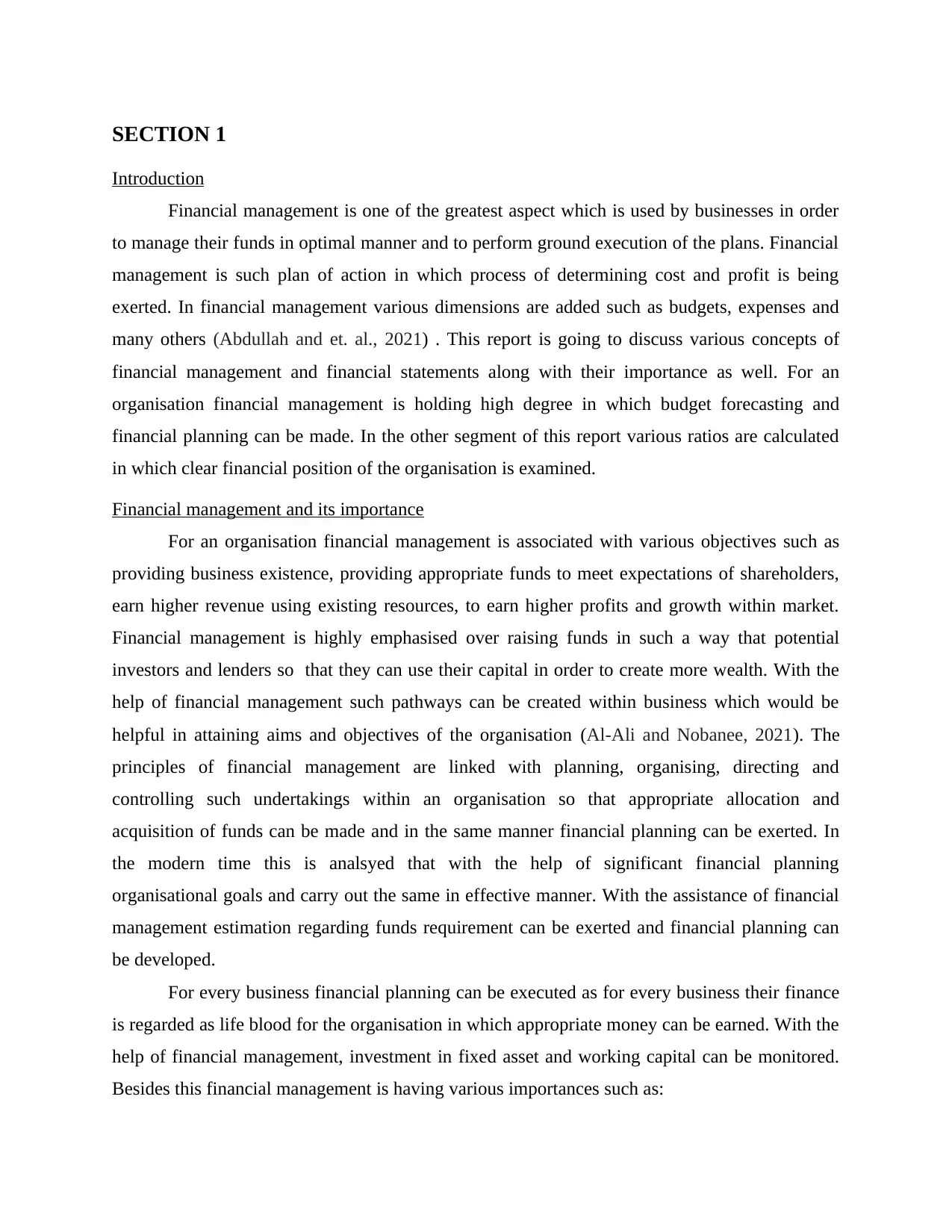
SECTION 1
Introduction
Financial management is one of the greatest aspect which is used by businesses in order
to manage their funds in optimal manner and to perform ground execution of the plans. Financial
management is such plan of action in which process of determining cost and profit is being
exerted. In financial management various dimensions are added such as budgets, expenses and
many others (Abdullah and et. al., 2021) . This report is going to discuss various concepts of
financial management and financial statements along with their importance as well. For an
organisation financial management is holding high degree in which budget forecasting and
financial planning can be made. In the other segment of this report various ratios are calculated
in which clear financial position of the organisation is examined.
Financial management and its importance
For an organisation financial management is associated with various objectives such as
providing business existence, providing appropriate funds to meet expectations of shareholders,
earn higher revenue using existing resources, to earn higher profits and growth within market.
Financial management is highly emphasised over raising funds in such a way that potential
investors and lenders so that they can use their capital in order to create more wealth. With the
help of financial management such pathways can be created within business which would be
helpful in attaining aims and objectives of the organisation (Al-Ali and Nobanee, 2021). The
principles of financial management are linked with planning, organising, directing and
controlling such undertakings within an organisation so that appropriate allocation and
acquisition of funds can be made and in the same manner financial planning can be exerted. In
the modern time this is analsyed that with the help of significant financial planning
organisational goals and carry out the same in effective manner. With the assistance of financial
management estimation regarding funds requirement can be exerted and financial planning can
be developed.
For every business financial planning can be executed as for every business their finance
is regarded as life blood for the organisation in which appropriate money can be earned. With the
help of financial management, investment in fixed asset and working capital can be monitored.
Besides this financial management is having various importances such as:
Introduction
Financial management is one of the greatest aspect which is used by businesses in order
to manage their funds in optimal manner and to perform ground execution of the plans. Financial
management is such plan of action in which process of determining cost and profit is being
exerted. In financial management various dimensions are added such as budgets, expenses and
many others (Abdullah and et. al., 2021) . This report is going to discuss various concepts of
financial management and financial statements along with their importance as well. For an
organisation financial management is holding high degree in which budget forecasting and
financial planning can be made. In the other segment of this report various ratios are calculated
in which clear financial position of the organisation is examined.
Financial management and its importance
For an organisation financial management is associated with various objectives such as
providing business existence, providing appropriate funds to meet expectations of shareholders,
earn higher revenue using existing resources, to earn higher profits and growth within market.
Financial management is highly emphasised over raising funds in such a way that potential
investors and lenders so that they can use their capital in order to create more wealth. With the
help of financial management such pathways can be created within business which would be
helpful in attaining aims and objectives of the organisation (Al-Ali and Nobanee, 2021). The
principles of financial management are linked with planning, organising, directing and
controlling such undertakings within an organisation so that appropriate allocation and
acquisition of funds can be made and in the same manner financial planning can be exerted. In
the modern time this is analsyed that with the help of significant financial planning
organisational goals and carry out the same in effective manner. With the assistance of financial
management estimation regarding funds requirement can be exerted and financial planning can
be developed.
For every business financial planning can be executed as for every business their finance
is regarded as life blood for the organisation in which appropriate money can be earned. With the
help of financial management, investment in fixed asset and working capital can be monitored.
Besides this financial management is having various importances such as:
⊘ This is a preview!⊘
Do you want full access?
Subscribe today to unlock all pages.

Trusted by 1+ million students worldwide
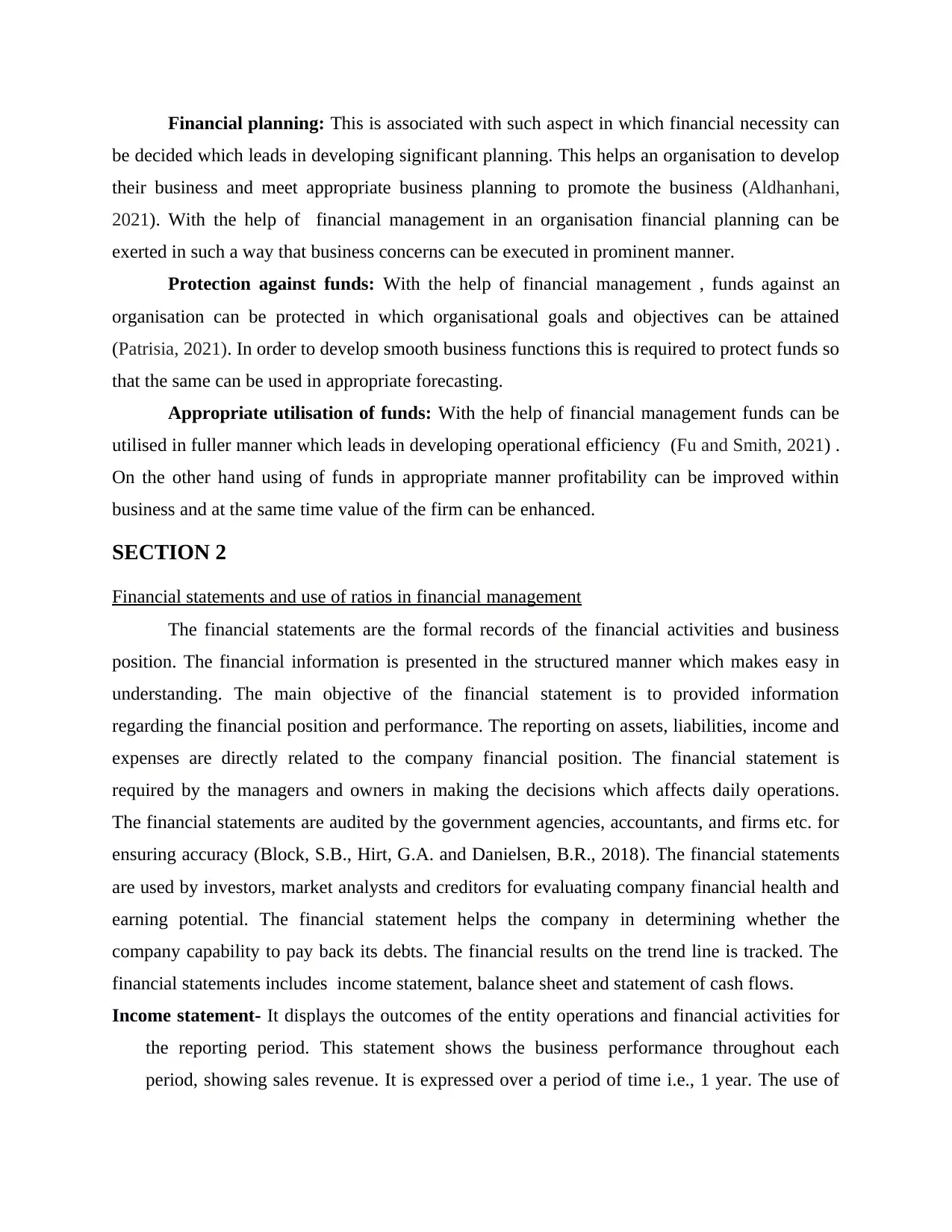
Financial planning: This is associated with such aspect in which financial necessity can
be decided which leads in developing significant planning. This helps an organisation to develop
their business and meet appropriate business planning to promote the business (Aldhanhani,
2021). With the help of financial management in an organisation financial planning can be
exerted in such a way that business concerns can be executed in prominent manner.
Protection against funds: With the help of financial management , funds against an
organisation can be protected in which organisational goals and objectives can be attained
(Patrisia, 2021). In order to develop smooth business functions this is required to protect funds so
that the same can be used in appropriate forecasting.
Appropriate utilisation of funds: With the help of financial management funds can be
utilised in fuller manner which leads in developing operational efficiency (Fu and Smith, 2021) .
On the other hand using of funds in appropriate manner profitability can be improved within
business and at the same time value of the firm can be enhanced.
SECTION 2
Financial statements and use of ratios in financial management
The financial statements are the formal records of the financial activities and business
position. The financial information is presented in the structured manner which makes easy in
understanding. The main objective of the financial statement is to provided information
regarding the financial position and performance. The reporting on assets, liabilities, income and
expenses are directly related to the company financial position. The financial statement is
required by the managers and owners in making the decisions which affects daily operations.
The financial statements are audited by the government agencies, accountants, and firms etc. for
ensuring accuracy (Block, S.B., Hirt, G.A. and Danielsen, B.R., 2018). The financial statements
are used by investors, market analysts and creditors for evaluating company financial health and
earning potential. The financial statement helps the company in determining whether the
company capability to pay back its debts. The financial results on the trend line is tracked. The
financial statements includes income statement, balance sheet and statement of cash flows.
Income statement- It displays the outcomes of the entity operations and financial activities for
the reporting period. This statement shows the business performance throughout each
period, showing sales revenue. It is expressed over a period of time i.e., 1 year. The use of
be decided which leads in developing significant planning. This helps an organisation to develop
their business and meet appropriate business planning to promote the business (Aldhanhani,
2021). With the help of financial management in an organisation financial planning can be
exerted in such a way that business concerns can be executed in prominent manner.
Protection against funds: With the help of financial management , funds against an
organisation can be protected in which organisational goals and objectives can be attained
(Patrisia, 2021). In order to develop smooth business functions this is required to protect funds so
that the same can be used in appropriate forecasting.
Appropriate utilisation of funds: With the help of financial management funds can be
utilised in fuller manner which leads in developing operational efficiency (Fu and Smith, 2021) .
On the other hand using of funds in appropriate manner profitability can be improved within
business and at the same time value of the firm can be enhanced.
SECTION 2
Financial statements and use of ratios in financial management
The financial statements are the formal records of the financial activities and business
position. The financial information is presented in the structured manner which makes easy in
understanding. The main objective of the financial statement is to provided information
regarding the financial position and performance. The reporting on assets, liabilities, income and
expenses are directly related to the company financial position. The financial statement is
required by the managers and owners in making the decisions which affects daily operations.
The financial statements are audited by the government agencies, accountants, and firms etc. for
ensuring accuracy (Block, S.B., Hirt, G.A. and Danielsen, B.R., 2018). The financial statements
are used by investors, market analysts and creditors for evaluating company financial health and
earning potential. The financial statement helps the company in determining whether the
company capability to pay back its debts. The financial results on the trend line is tracked. The
financial statements includes income statement, balance sheet and statement of cash flows.
Income statement- It displays the outcomes of the entity operations and financial activities for
the reporting period. This statement shows the business performance throughout each
period, showing sales revenue. It is expressed over a period of time i.e., 1 year. The use of
Paraphrase This Document
Need a fresh take? Get an instant paraphrase of this document with our AI Paraphraser
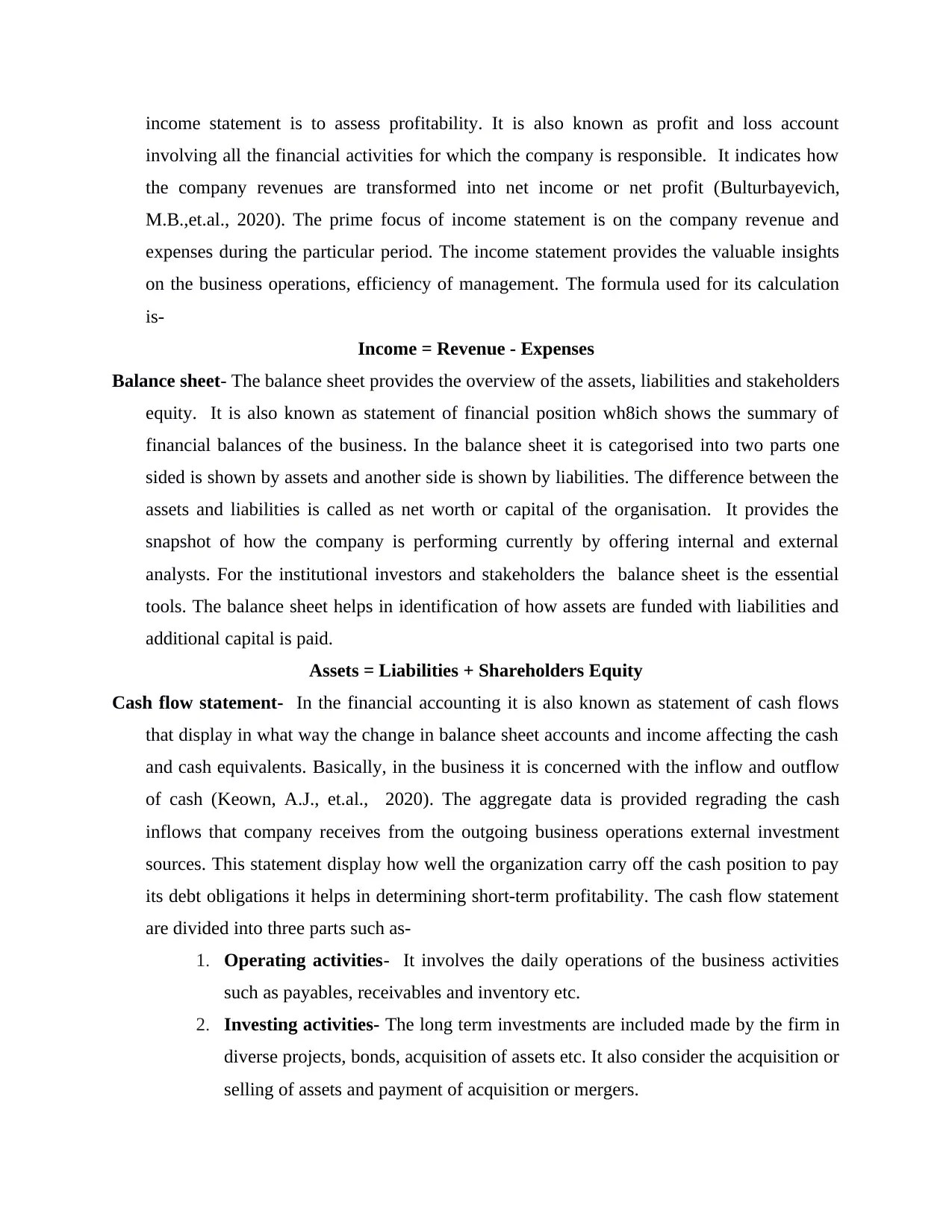
income statement is to assess profitability. It is also known as profit and loss account
involving all the financial activities for which the company is responsible. It indicates how
the company revenues are transformed into net income or net profit (Bulturbayevich,
M.B.,et.al., 2020). The prime focus of income statement is on the company revenue and
expenses during the particular period. The income statement provides the valuable insights
on the business operations, efficiency of management. The formula used for its calculation
is-
Income = Revenue - Expenses
Balance sheet- The balance sheet provides the overview of the assets, liabilities and stakeholders
equity. It is also known as statement of financial position wh8ich shows the summary of
financial balances of the business. In the balance sheet it is categorised into two parts one
sided is shown by assets and another side is shown by liabilities. The difference between the
assets and liabilities is called as net worth or capital of the organisation. It provides the
snapshot of how the company is performing currently by offering internal and external
analysts. For the institutional investors and stakeholders the balance sheet is the essential
tools. The balance sheet helps in identification of how assets are funded with liabilities and
additional capital is paid.
Assets = Liabilities + Shareholders Equity
Cash flow statement- In the financial accounting it is also known as statement of cash flows
that display in what way the change in balance sheet accounts and income affecting the cash
and cash equivalents. Basically, in the business it is concerned with the inflow and outflow
of cash (Keown, A.J., et.al., 2020). The aggregate data is provided regrading the cash
inflows that company receives from the outgoing business operations external investment
sources. This statement display how well the organization carry off the cash position to pay
its debt obligations it helps in determining short-term profitability. The cash flow statement
are divided into three parts such as-
1. Operating activities- It involves the daily operations of the business activities
such as payables, receivables and inventory etc.
2. Investing activities- The long term investments are included made by the firm in
diverse projects, bonds, acquisition of assets etc. It also consider the acquisition or
selling of assets and payment of acquisition or mergers.
involving all the financial activities for which the company is responsible. It indicates how
the company revenues are transformed into net income or net profit (Bulturbayevich,
M.B.,et.al., 2020). The prime focus of income statement is on the company revenue and
expenses during the particular period. The income statement provides the valuable insights
on the business operations, efficiency of management. The formula used for its calculation
is-
Income = Revenue - Expenses
Balance sheet- The balance sheet provides the overview of the assets, liabilities and stakeholders
equity. It is also known as statement of financial position wh8ich shows the summary of
financial balances of the business. In the balance sheet it is categorised into two parts one
sided is shown by assets and another side is shown by liabilities. The difference between the
assets and liabilities is called as net worth or capital of the organisation. It provides the
snapshot of how the company is performing currently by offering internal and external
analysts. For the institutional investors and stakeholders the balance sheet is the essential
tools. The balance sheet helps in identification of how assets are funded with liabilities and
additional capital is paid.
Assets = Liabilities + Shareholders Equity
Cash flow statement- In the financial accounting it is also known as statement of cash flows
that display in what way the change in balance sheet accounts and income affecting the cash
and cash equivalents. Basically, in the business it is concerned with the inflow and outflow
of cash (Keown, A.J., et.al., 2020). The aggregate data is provided regrading the cash
inflows that company receives from the outgoing business operations external investment
sources. This statement display how well the organization carry off the cash position to pay
its debt obligations it helps in determining short-term profitability. The cash flow statement
are divided into three parts such as-
1. Operating activities- It involves the daily operations of the business activities
such as payables, receivables and inventory etc.
2. Investing activities- The long term investments are included made by the firm in
diverse projects, bonds, acquisition of assets etc. It also consider the acquisition or
selling of assets and payment of acquisition or mergers.
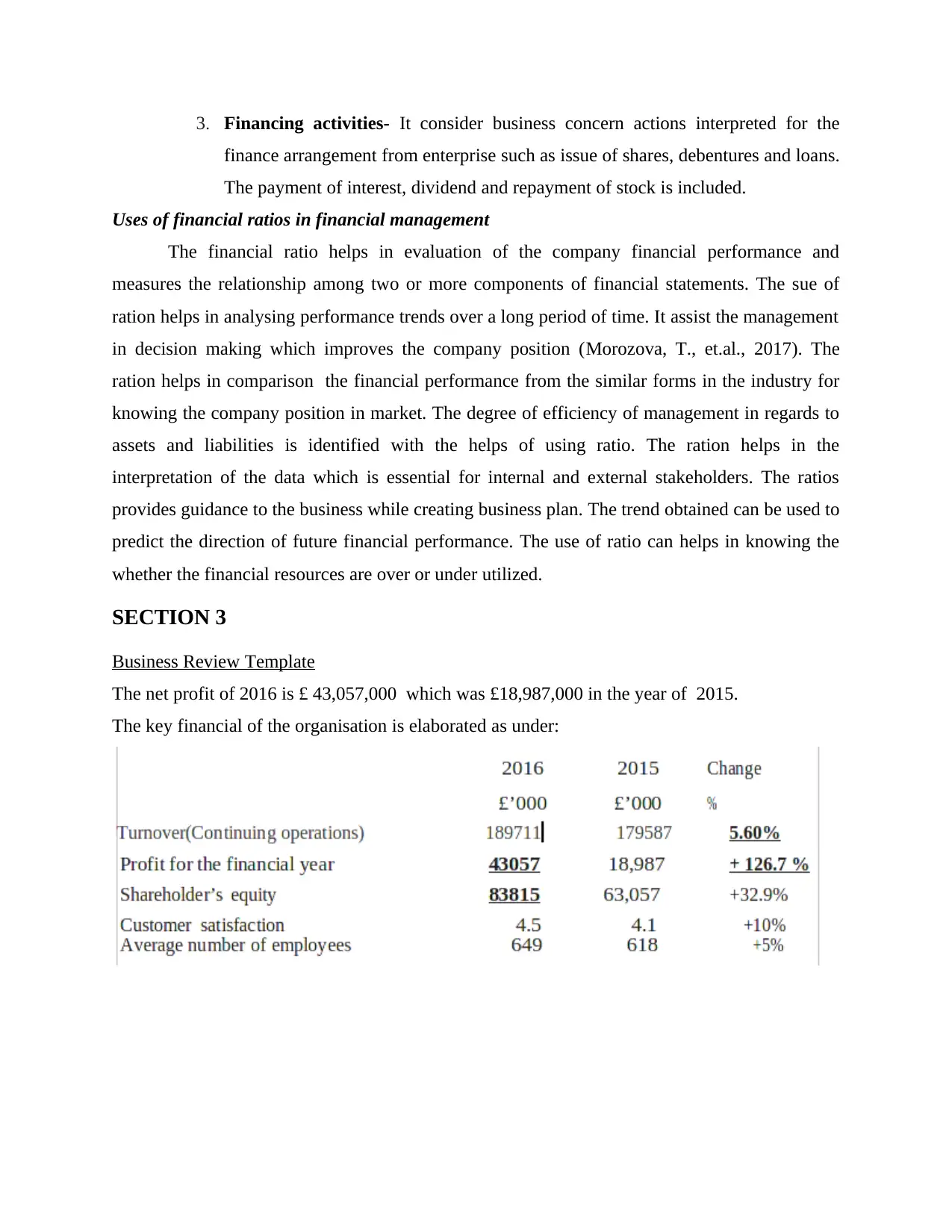
3. Financing activities- It consider business concern actions interpreted for the
finance arrangement from enterprise such as issue of shares, debentures and loans.
The payment of interest, dividend and repayment of stock is included.
Uses of financial ratios in financial management
The financial ratio helps in evaluation of the company financial performance and
measures the relationship among two or more components of financial statements. The sue of
ration helps in analysing performance trends over a long period of time. It assist the management
in decision making which improves the company position (Morozova, T., et.al., 2017). The
ration helps in comparison the financial performance from the similar forms in the industry for
knowing the company position in market. The degree of efficiency of management in regards to
assets and liabilities is identified with the helps of using ratio. The ration helps in the
interpretation of the data which is essential for internal and external stakeholders. The ratios
provides guidance to the business while creating business plan. The trend obtained can be used to
predict the direction of future financial performance. The use of ratio can helps in knowing the
whether the financial resources are over or under utilized.
SECTION 3
Business Review Template
The net profit of 2016 is £ 43,057,000 which was £18,987,000 in the year of 2015.
The key financial of the organisation is elaborated as under:
finance arrangement from enterprise such as issue of shares, debentures and loans.
The payment of interest, dividend and repayment of stock is included.
Uses of financial ratios in financial management
The financial ratio helps in evaluation of the company financial performance and
measures the relationship among two or more components of financial statements. The sue of
ration helps in analysing performance trends over a long period of time. It assist the management
in decision making which improves the company position (Morozova, T., et.al., 2017). The
ration helps in comparison the financial performance from the similar forms in the industry for
knowing the company position in market. The degree of efficiency of management in regards to
assets and liabilities is identified with the helps of using ratio. The ration helps in the
interpretation of the data which is essential for internal and external stakeholders. The ratios
provides guidance to the business while creating business plan. The trend obtained can be used to
predict the direction of future financial performance. The use of ratio can helps in knowing the
whether the financial resources are over or under utilized.
SECTION 3
Business Review Template
The net profit of 2016 is £ 43,057,000 which was £18,987,000 in the year of 2015.
The key financial of the organisation is elaborated as under:
⊘ This is a preview!⊘
Do you want full access?
Subscribe today to unlock all pages.

Trusted by 1+ million students worldwide
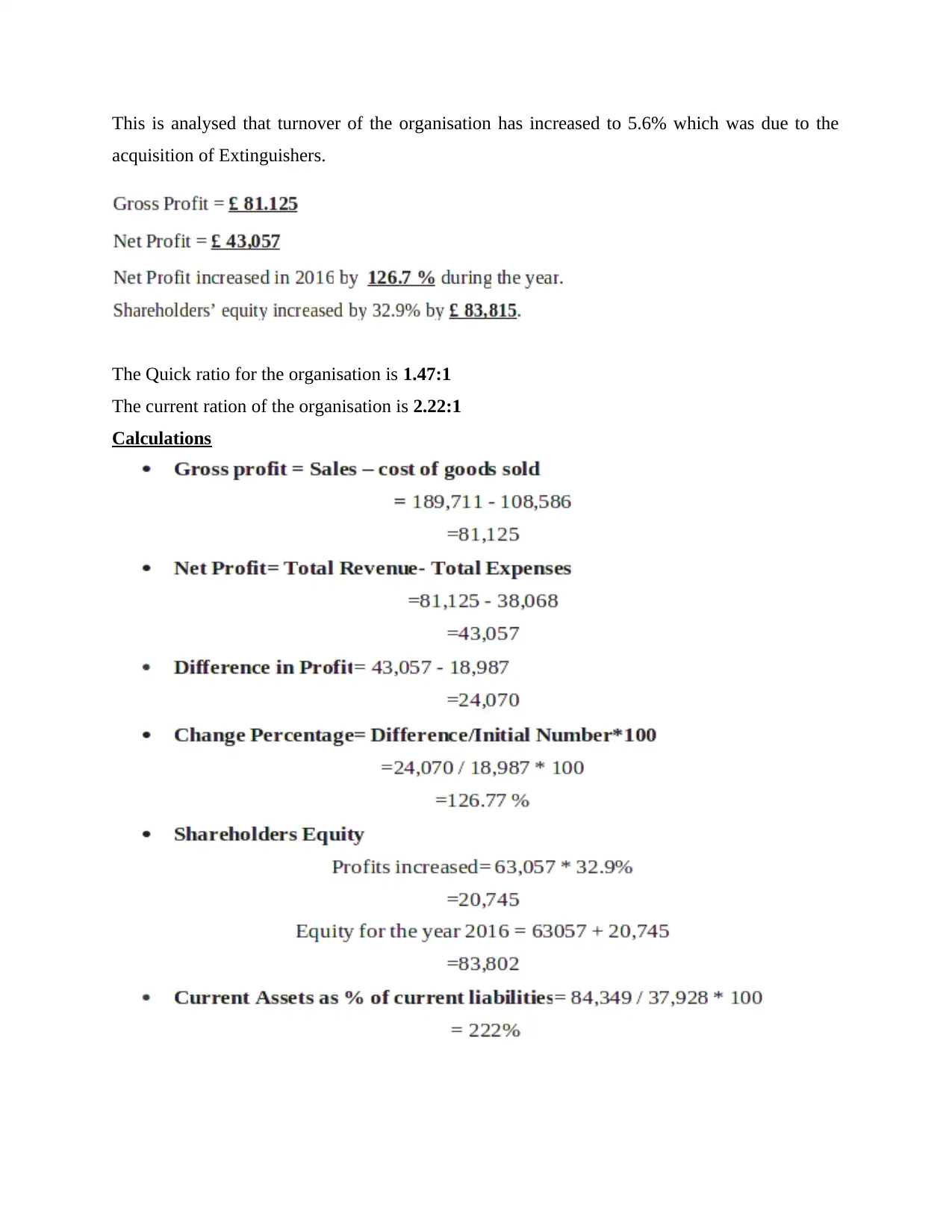
This is analysed that turnover of the organisation has increased to 5.6% which was due to the
acquisition of Extinguishers.
The Quick ratio for the organisation is 1.47:1
The current ration of the organisation is 2.22:1
Calculations
acquisition of Extinguishers.
The Quick ratio for the organisation is 1.47:1
The current ration of the organisation is 2.22:1
Calculations
Paraphrase This Document
Need a fresh take? Get an instant paraphrase of this document with our AI Paraphraser

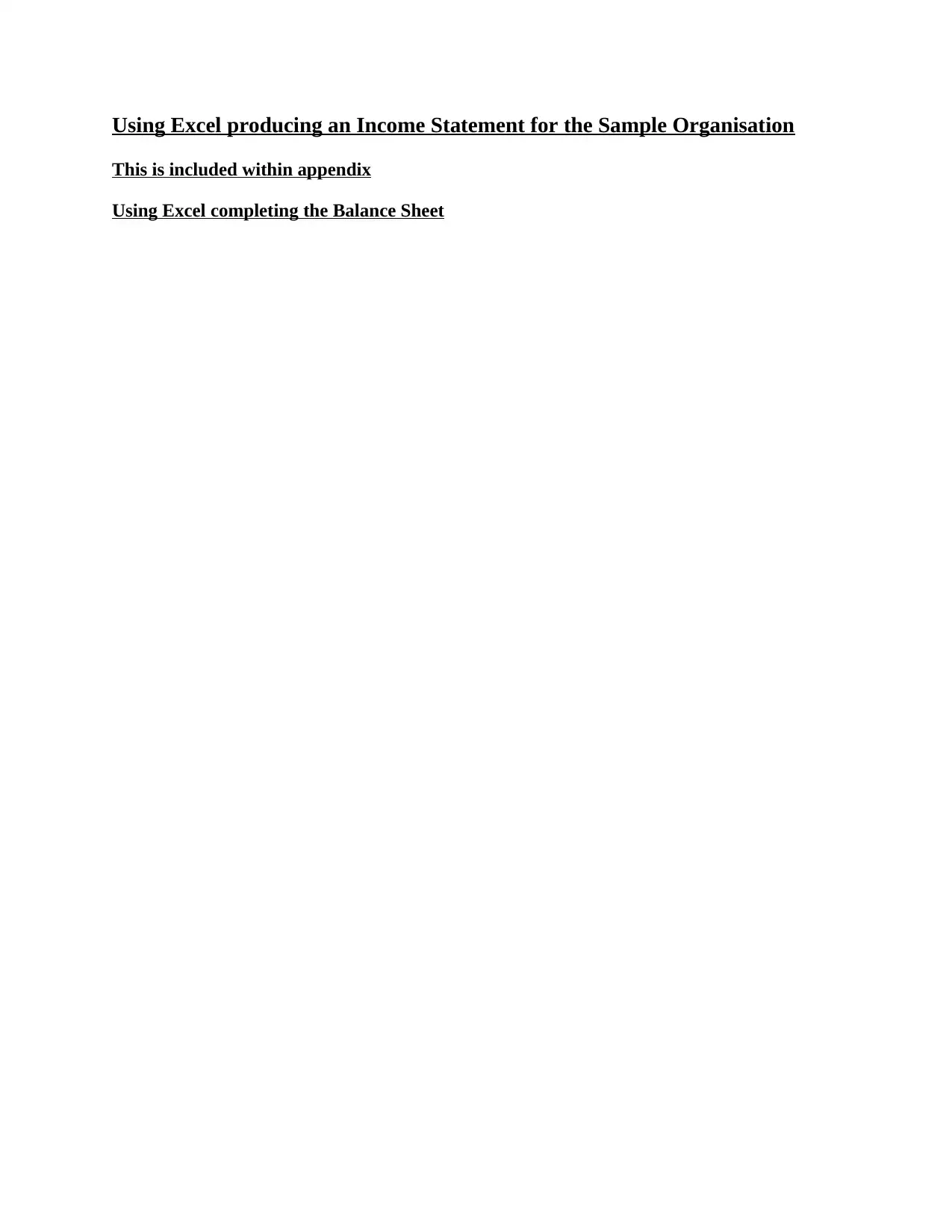
Using Excel producing an Income Statement for the Sample Organisation
This is included within appendix
Using Excel completing the Balance Sheet
This is included within appendix
Using Excel completing the Balance Sheet
⊘ This is a preview!⊘
Do you want full access?
Subscribe today to unlock all pages.

Trusted by 1+ million students worldwide
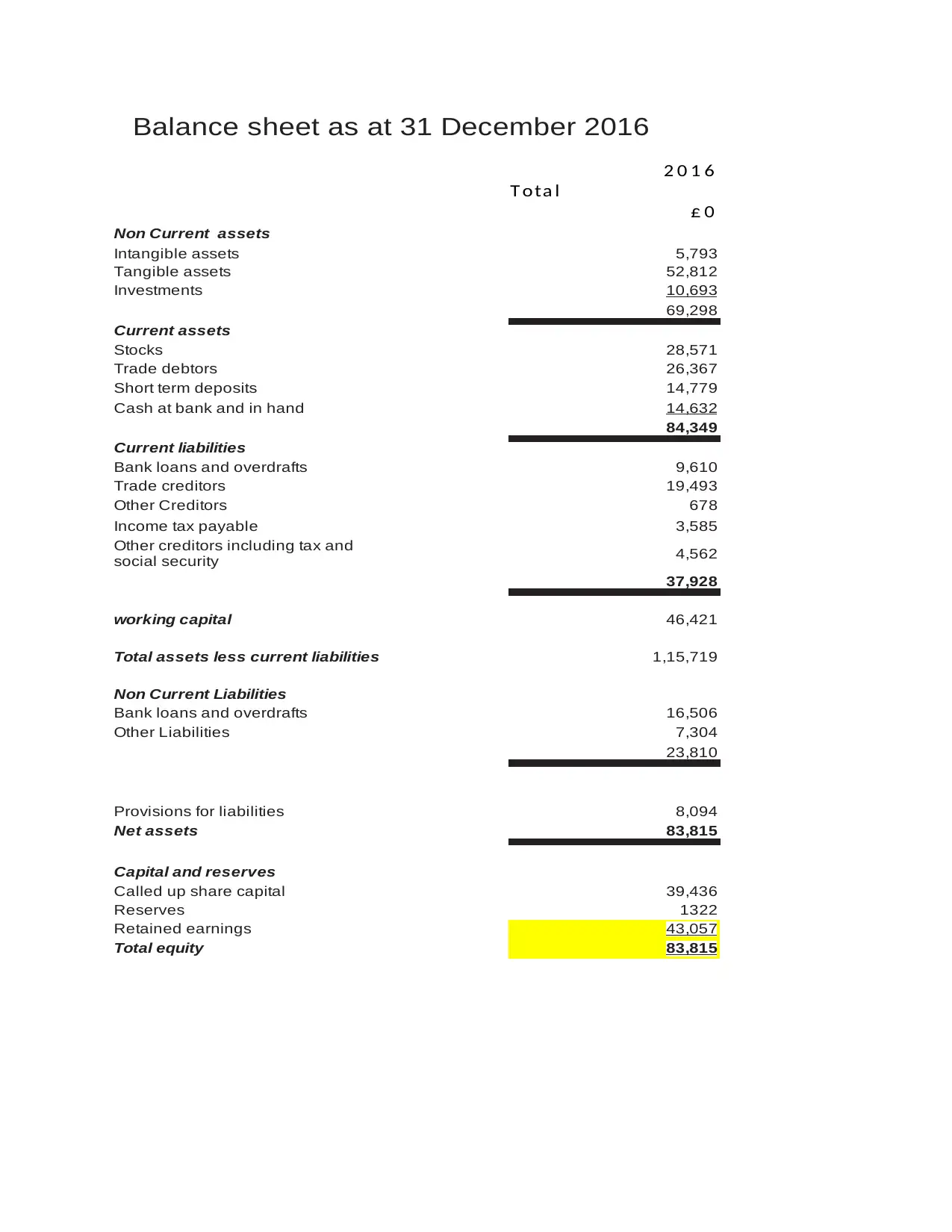
Balance sheet as at 31 December 2016
2 0 1 6
T ota l
£ 0
Non Current assets
Intangible assets 5,793
Tangible assets 52,812
Investments 10,693
69,298
Current assets
Stocks 28,571
Trade debtors 26,367
Short term deposits 14,779
Cash at bank and in hand 14,632
84,349
Current liabilities
Bank loans and overdrafts 9,610
Trade creditors 19,493
Other Creditors 678
Income tax payable 3,585
4,562
37,928
working capital 46,421
Total assets less current liabilities 1,15,719
Non Current Liabilities
Bank loans and overdrafts 16,506
Other Liabilities 7,304
23,810
Provisions for liabilities 8,094
Net assets 83,815
Capital and reserves
Called up share capital 39,436
Reserves 1322
Retained earnings 43,057
Total equity 83,815
Other creditors including tax and
social security
2 0 1 6
T ota l
£ 0
Non Current assets
Intangible assets 5,793
Tangible assets 52,812
Investments 10,693
69,298
Current assets
Stocks 28,571
Trade debtors 26,367
Short term deposits 14,779
Cash at bank and in hand 14,632
84,349
Current liabilities
Bank loans and overdrafts 9,610
Trade creditors 19,493
Other Creditors 678
Income tax payable 3,585
4,562
37,928
working capital 46,421
Total assets less current liabilities 1,15,719
Non Current Liabilities
Bank loans and overdrafts 16,506
Other Liabilities 7,304
23,810
Provisions for liabilities 8,094
Net assets 83,815
Capital and reserves
Called up share capital 39,436
Reserves 1322
Retained earnings 43,057
Total equity 83,815
Other creditors including tax and
social security
Paraphrase This Document
Need a fresh take? Get an instant paraphrase of this document with our AI Paraphraser
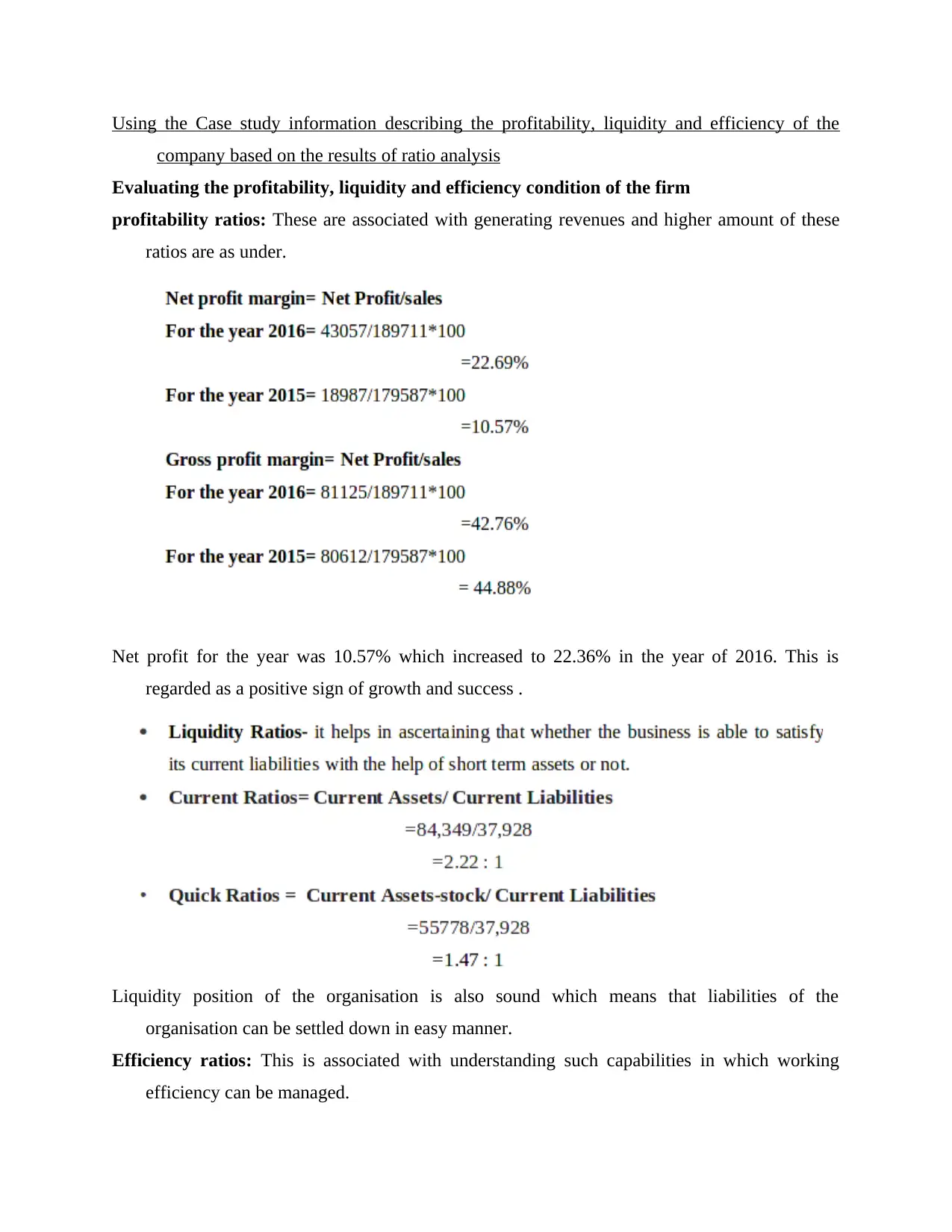
Using the Case study information describing the profitability, liquidity and efficiency of the
company based on the results of ratio analysis
Evaluating the profitability, liquidity and efficiency condition of the firm
profitability ratios: These are associated with generating revenues and higher amount of these
ratios are as under.
Net profit for the year was 10.57% which increased to 22.36% in the year of 2016. This is
regarded as a positive sign of growth and success .
Liquidity position of the organisation is also sound which means that liabilities of the
organisation can be settled down in easy manner.
Efficiency ratios: This is associated with understanding such capabilities in which working
efficiency can be managed.
company based on the results of ratio analysis
Evaluating the profitability, liquidity and efficiency condition of the firm
profitability ratios: These are associated with generating revenues and higher amount of these
ratios are as under.
Net profit for the year was 10.57% which increased to 22.36% in the year of 2016. This is
regarded as a positive sign of growth and success .
Liquidity position of the organisation is also sound which means that liabilities of the
organisation can be settled down in easy manner.
Efficiency ratios: This is associated with understanding such capabilities in which working
efficiency can be managed.
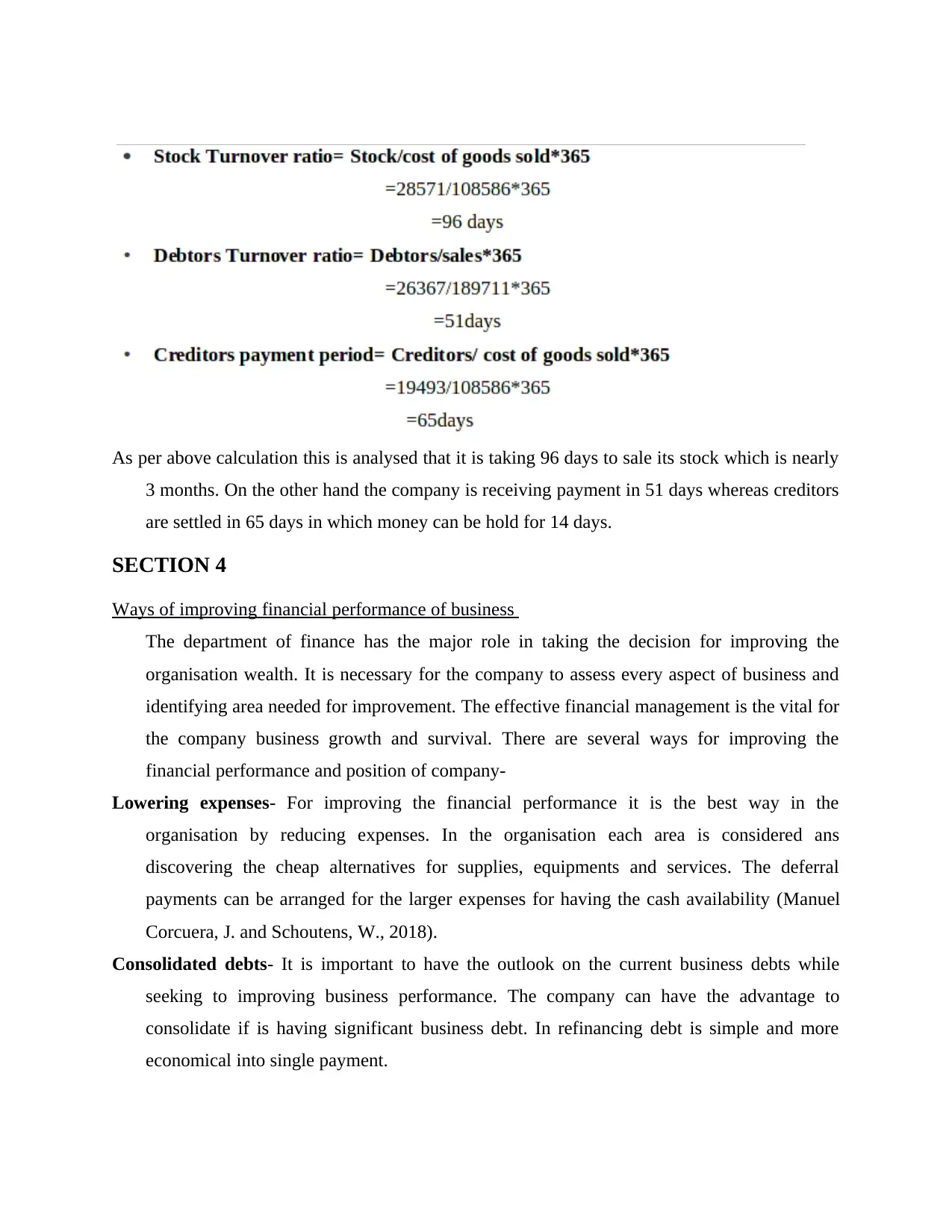
As per above calculation this is analysed that it is taking 96 days to sale its stock which is nearly
3 months. On the other hand the company is receiving payment in 51 days whereas creditors
are settled in 65 days in which money can be hold for 14 days.
SECTION 4
Ways of improving financial performance of business
The department of finance has the major role in taking the decision for improving the
organisation wealth. It is necessary for the company to assess every aspect of business and
identifying area needed for improvement. The effective financial management is the vital for
the company business growth and survival. There are several ways for improving the
financial performance and position of company-
Lowering expenses- For improving the financial performance it is the best way in the
organisation by reducing expenses. In the organisation each area is considered ans
discovering the cheap alternatives for supplies, equipments and services. The deferral
payments can be arranged for the larger expenses for having the cash availability (Manuel
Corcuera, J. and Schoutens, W., 2018).
Consolidated debts- It is important to have the outlook on the current business debts while
seeking to improving business performance. The company can have the advantage to
consolidate if is having significant business debt. In refinancing debt is simple and more
economical into single payment.
3 months. On the other hand the company is receiving payment in 51 days whereas creditors
are settled in 65 days in which money can be hold for 14 days.
SECTION 4
Ways of improving financial performance of business
The department of finance has the major role in taking the decision for improving the
organisation wealth. It is necessary for the company to assess every aspect of business and
identifying area needed for improvement. The effective financial management is the vital for
the company business growth and survival. There are several ways for improving the
financial performance and position of company-
Lowering expenses- For improving the financial performance it is the best way in the
organisation by reducing expenses. In the organisation each area is considered ans
discovering the cheap alternatives for supplies, equipments and services. The deferral
payments can be arranged for the larger expenses for having the cash availability (Manuel
Corcuera, J. and Schoutens, W., 2018).
Consolidated debts- It is important to have the outlook on the current business debts while
seeking to improving business performance. The company can have the advantage to
consolidate if is having significant business debt. In refinancing debt is simple and more
economical into single payment.
⊘ This is a preview!⊘
Do you want full access?
Subscribe today to unlock all pages.

Trusted by 1+ million students worldwide
1 out of 15
Related Documents
Your All-in-One AI-Powered Toolkit for Academic Success.
+13062052269
info@desklib.com
Available 24*7 on WhatsApp / Email
![[object Object]](/_next/static/media/star-bottom.7253800d.svg)
Unlock your academic potential
Copyright © 2020–2025 A2Z Services. All Rights Reserved. Developed and managed by ZUCOL.



